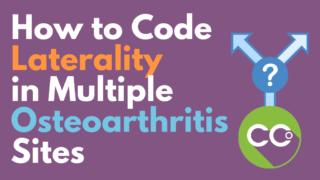 Question: “My question is in regards to ICD-10 coding of OA (osteoarthritis) when multiple sides are listed with laterality i.e. left knee, left shoulder, right hand. Is it appropriate to code each one out, OR should the multiple OA code be used?”
Question: “My question is in regards to ICD-10 coding of OA (osteoarthritis) when multiple sides are listed with laterality i.e. left knee, left shoulder, right hand. Is it appropriate to code each one out, OR should the multiple OA code be used?”
Answer: For this one, when we’re talking about osteoarthritis, the guidelines in ICD-10 tell you that if there is a code like osteoarthritis where they give you a multiple sites option and the patient has that condition in multiple joints, it is perfectly acceptable to use that multiple sites option.
You can find this in your ICD-10 Manual under I.C.13.a. When we write I.C.13.a, that means it is in the front of the ICD-10 Manual in the guidelines section. “I” says it’s section 1, “C” says it is section “C” of part 1 (which is the Chapter Specific Guidelines), specifically it’s in chapter 13 (which is musculoskeletal), and “A” is specific to multiple sites.
What’s The Reason for the Osteoarthritis Visit, Though?
A word of caution, however, is needed. If you’re just seeing a patient for perhaps a routine follow-up with your doctor and they have osteoarthritis in their hip, in their knee, in their shoulder and kind of everywhere it’s easier just to say, “they have osteoarthritis everywhere.”
If they’re coming in for a specific osteoarthritis issues, that should be treated differently. For example, if they’re coming in to be seen specifically for their hip pain because they have osteoarthritis in their hip, their knee and their shoulder, but we’re evaluating them for hip replacement because the osteoarthritis in their hip has worsened.
In that situation, I would encourage you to pull that hip part out separately because most of the insurance carriers are looking for that. They’re looking for that specificity when they’re talking about medical necessity, especially when it comes to the actual surgery for the hip replacement. If you say you did a hip replacement because the patient has multiple sites OA the insurance company may not pay. They may say, “we want to know for sure that it’s in their hip and not in their shoulder and you replaced their hip for no reason”. That’s where insurance companies look for specificity. So keep in mind the reason you are billing. Be specific, especially if you know it’s going to affect medical necessity and possibly payment.
![[CCO] Certification Coaching Organization LLC [CCO] Certification Coaching Organization LLC](https://www.cco.us/wp-content/uploads/2015/05/CCO-Logo-2015-d3-500px.png)